ASL402 Case Study: Autism Support Across the Lifespan Analysis
VerifiedAdded on 2023/05/30
|10
|3059
|90
Case Study
AI Summary
This case study focuses on Pat, a 60-year-old male with potential autism, examining his life experiences and support needs. It explores his early challenges with bullying, social isolation, and difficulties in school, leading to his interest in technology and successful career in IT. The case highlights the impact of workplace changes, family dynamics (including children with autism), and mental health issues (anxiety and depression) on Pat's well-being. The study analyzes key issues such as lack of workplace support, family stressors, and social isolation, and discusses how adulthood experiences can significantly impact individuals with autism. It also addresses the changes and challenges faced by individuals and caregivers, emphasizing the need for social, psychological, employment, and pharmacological support. The case study provides insights into the importance of a person-first approach to understand and address the complexities of autism across the lifespan.
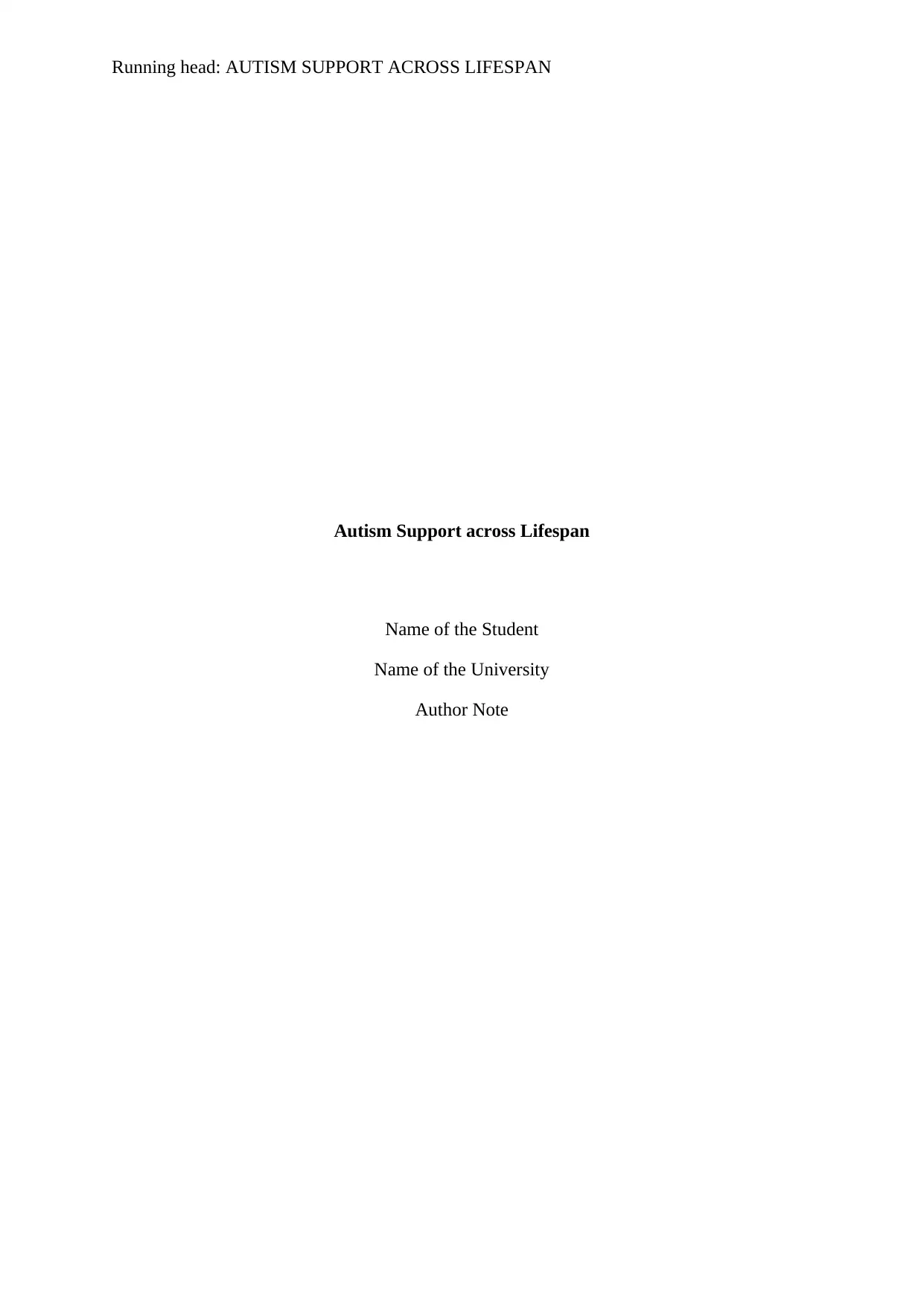
Running head: AUTISM SUPPORT ACROSS LIFESPAN
Autism Support across Lifespan
Name of the Student
Name of the University
Author Note
Autism Support across Lifespan
Name of the Student
Name of the University
Author Note
Paraphrase This Document
Need a fresh take? Get an instant paraphrase of this document with our AI Paraphraser
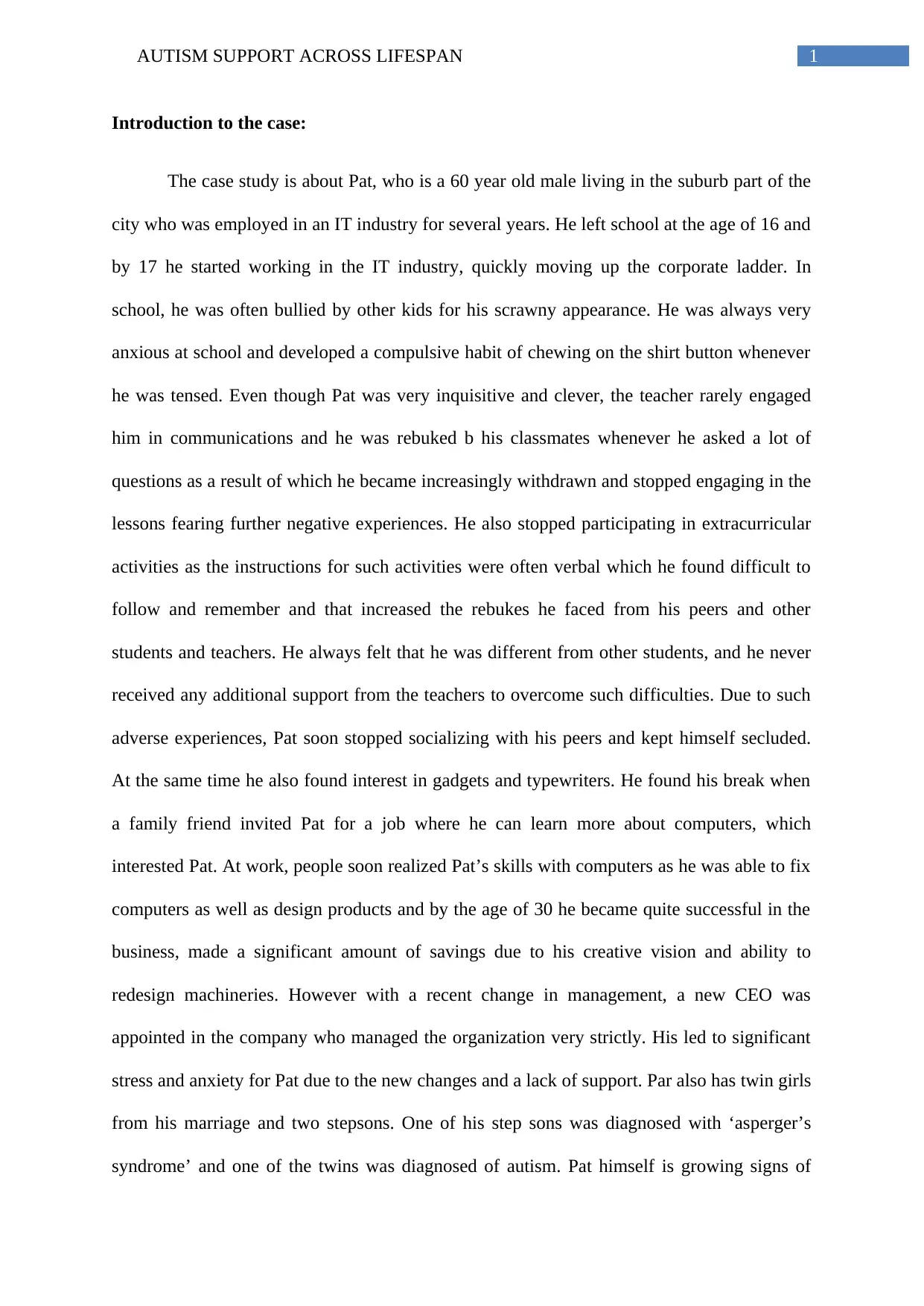
1AUTISM SUPPORT ACROSS LIFESPAN
Introduction to the case:
The case study is about Pat, who is a 60 year old male living in the suburb part of the
city who was employed in an IT industry for several years. He left school at the age of 16 and
by 17 he started working in the IT industry, quickly moving up the corporate ladder. In
school, he was often bullied by other kids for his scrawny appearance. He was always very
anxious at school and developed a compulsive habit of chewing on the shirt button whenever
he was tensed. Even though Pat was very inquisitive and clever, the teacher rarely engaged
him in communications and he was rebuked b his classmates whenever he asked a lot of
questions as a result of which he became increasingly withdrawn and stopped engaging in the
lessons fearing further negative experiences. He also stopped participating in extracurricular
activities as the instructions for such activities were often verbal which he found difficult to
follow and remember and that increased the rebukes he faced from his peers and other
students and teachers. He always felt that he was different from other students, and he never
received any additional support from the teachers to overcome such difficulties. Due to such
adverse experiences, Pat soon stopped socializing with his peers and kept himself secluded.
At the same time he also found interest in gadgets and typewriters. He found his break when
a family friend invited Pat for a job where he can learn more about computers, which
interested Pat. At work, people soon realized Pat’s skills with computers as he was able to fix
computers as well as design products and by the age of 30 he became quite successful in the
business, made a significant amount of savings due to his creative vision and ability to
redesign machineries. However with a recent change in management, a new CEO was
appointed in the company who managed the organization very strictly. His led to significant
stress and anxiety for Pat due to the new changes and a lack of support. Par also has twin girls
from his marriage and two stepsons. One of his step sons was diagnosed with ‘asperger’s
syndrome’ and one of the twins was diagnosed of autism. Pat himself is growing signs of
Introduction to the case:
The case study is about Pat, who is a 60 year old male living in the suburb part of the
city who was employed in an IT industry for several years. He left school at the age of 16 and
by 17 he started working in the IT industry, quickly moving up the corporate ladder. In
school, he was often bullied by other kids for his scrawny appearance. He was always very
anxious at school and developed a compulsive habit of chewing on the shirt button whenever
he was tensed. Even though Pat was very inquisitive and clever, the teacher rarely engaged
him in communications and he was rebuked b his classmates whenever he asked a lot of
questions as a result of which he became increasingly withdrawn and stopped engaging in the
lessons fearing further negative experiences. He also stopped participating in extracurricular
activities as the instructions for such activities were often verbal which he found difficult to
follow and remember and that increased the rebukes he faced from his peers and other
students and teachers. He always felt that he was different from other students, and he never
received any additional support from the teachers to overcome such difficulties. Due to such
adverse experiences, Pat soon stopped socializing with his peers and kept himself secluded.
At the same time he also found interest in gadgets and typewriters. He found his break when
a family friend invited Pat for a job where he can learn more about computers, which
interested Pat. At work, people soon realized Pat’s skills with computers as he was able to fix
computers as well as design products and by the age of 30 he became quite successful in the
business, made a significant amount of savings due to his creative vision and ability to
redesign machineries. However with a recent change in management, a new CEO was
appointed in the company who managed the organization very strictly. His led to significant
stress and anxiety for Pat due to the new changes and a lack of support. Par also has twin girls
from his marriage and two stepsons. One of his step sons was diagnosed with ‘asperger’s
syndrome’ and one of the twins was diagnosed of autism. Pat himself is growing signs of

2AUTISM SUPPORT ACROSS LIFESPAN
anxiety and depression and is having frequent outbursts of temper. His wife feels now that
Pat might himself have Autism (Lo et al., 2018).
Development of adulthood support knowledge in autism
Autism Spectrum Disorder is a type of developmental disorder that inflicts the
neuronal development of individuals which affects the cognitive, social, emotional as well as
physical health of the individuals with varying ranges of severity. Its impact can include
communication and speech difficulties, learning disabilities, problems with social interactions
and obsessive or repetitive behaviors (Lo et al., 2018; Bradley et al., 2014). Due to such
impacts, adults living with Autism Spectrum Disorder have certain special care needs
(Anderson, 2018; Wong et al., 2014). Discussed below are some of the most significant
support needs for an adult with autism:
Employment: Securing employment can be challenging for individuals with Autism as factors
such as environmental noise, travelling and workplace changes can be stressful for them.
Even though the individuals might have the necessary skills to perform and even excel at
their job, the stress often can prevent their continued engagement with the employment.
Through employment support, the individuals can be taught strategies to over the stressors.
Also, the services can be used to develop organizational policies that can support the
employment of adults with autism and create a stress free environment (Sanders et al., 2015;
Lopez & Gerenser, 2017).
Accommodation: Supporting the accommodation for individuals with Autism can help them
to live more independently, either alone or with others depending on their preferences with
the necessary care always within reach. Supported living strategies can also be used in such
an aspect to ensure continued support for the individuals (Sarrett, 2018).
anxiety and depression and is having frequent outbursts of temper. His wife feels now that
Pat might himself have Autism (Lo et al., 2018).
Development of adulthood support knowledge in autism
Autism Spectrum Disorder is a type of developmental disorder that inflicts the
neuronal development of individuals which affects the cognitive, social, emotional as well as
physical health of the individuals with varying ranges of severity. Its impact can include
communication and speech difficulties, learning disabilities, problems with social interactions
and obsessive or repetitive behaviors (Lo et al., 2018; Bradley et al., 2014). Due to such
impacts, adults living with Autism Spectrum Disorder have certain special care needs
(Anderson, 2018; Wong et al., 2014). Discussed below are some of the most significant
support needs for an adult with autism:
Employment: Securing employment can be challenging for individuals with Autism as factors
such as environmental noise, travelling and workplace changes can be stressful for them.
Even though the individuals might have the necessary skills to perform and even excel at
their job, the stress often can prevent their continued engagement with the employment.
Through employment support, the individuals can be taught strategies to over the stressors.
Also, the services can be used to develop organizational policies that can support the
employment of adults with autism and create a stress free environment (Sanders et al., 2015;
Lopez & Gerenser, 2017).
Accommodation: Supporting the accommodation for individuals with Autism can help them
to live more independently, either alone or with others depending on their preferences with
the necessary care always within reach. Supported living strategies can also be used in such
an aspect to ensure continued support for the individuals (Sarrett, 2018).
⊘ This is a preview!⊘
Do you want full access?
Subscribe today to unlock all pages.

Trusted by 1+ million students worldwide
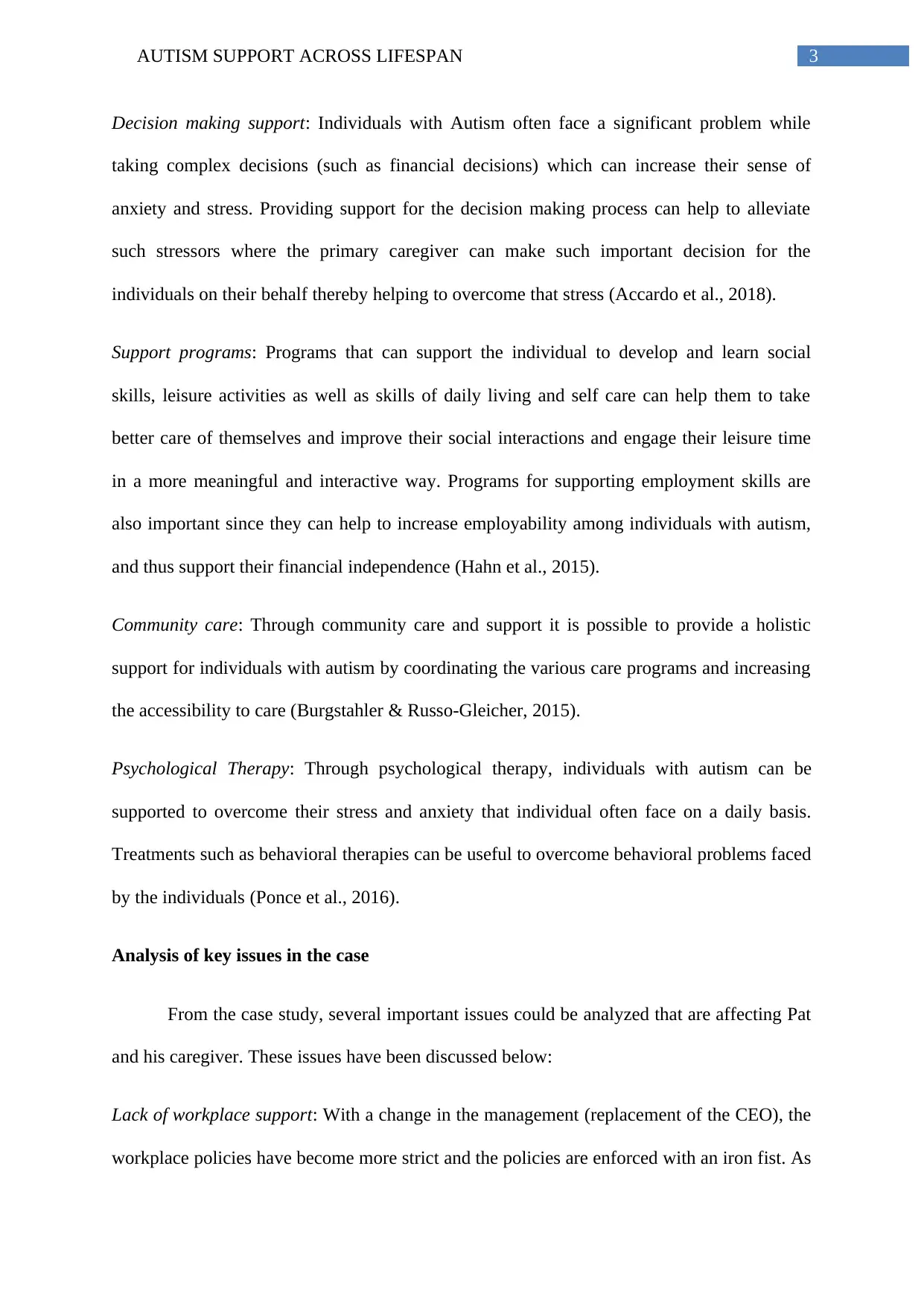
3AUTISM SUPPORT ACROSS LIFESPAN
Decision making support: Individuals with Autism often face a significant problem while
taking complex decisions (such as financial decisions) which can increase their sense of
anxiety and stress. Providing support for the decision making process can help to alleviate
such stressors where the primary caregiver can make such important decision for the
individuals on their behalf thereby helping to overcome that stress (Accardo et al., 2018).
Support programs: Programs that can support the individual to develop and learn social
skills, leisure activities as well as skills of daily living and self care can help them to take
better care of themselves and improve their social interactions and engage their leisure time
in a more meaningful and interactive way. Programs for supporting employment skills are
also important since they can help to increase employability among individuals with autism,
and thus support their financial independence (Hahn et al., 2015).
Community care: Through community care and support it is possible to provide a holistic
support for individuals with autism by coordinating the various care programs and increasing
the accessibility to care (Burgstahler & Russo-Gleicher, 2015).
Psychological Therapy: Through psychological therapy, individuals with autism can be
supported to overcome their stress and anxiety that individual often face on a daily basis.
Treatments such as behavioral therapies can be useful to overcome behavioral problems faced
by the individuals (Ponce et al., 2016).
Analysis of key issues in the case
From the case study, several important issues could be analyzed that are affecting Pat
and his caregiver. These issues have been discussed below:
Lack of workplace support: With a change in the management (replacement of the CEO), the
workplace policies have become more strict and the policies are enforced with an iron fist. As
Decision making support: Individuals with Autism often face a significant problem while
taking complex decisions (such as financial decisions) which can increase their sense of
anxiety and stress. Providing support for the decision making process can help to alleviate
such stressors where the primary caregiver can make such important decision for the
individuals on their behalf thereby helping to overcome that stress (Accardo et al., 2018).
Support programs: Programs that can support the individual to develop and learn social
skills, leisure activities as well as skills of daily living and self care can help them to take
better care of themselves and improve their social interactions and engage their leisure time
in a more meaningful and interactive way. Programs for supporting employment skills are
also important since they can help to increase employability among individuals with autism,
and thus support their financial independence (Hahn et al., 2015).
Community care: Through community care and support it is possible to provide a holistic
support for individuals with autism by coordinating the various care programs and increasing
the accessibility to care (Burgstahler & Russo-Gleicher, 2015).
Psychological Therapy: Through psychological therapy, individuals with autism can be
supported to overcome their stress and anxiety that individual often face on a daily basis.
Treatments such as behavioral therapies can be useful to overcome behavioral problems faced
by the individuals (Ponce et al., 2016).
Analysis of key issues in the case
From the case study, several important issues could be analyzed that are affecting Pat
and his caregiver. These issues have been discussed below:
Lack of workplace support: With a change in the management (replacement of the CEO), the
workplace policies have become more strict and the policies are enforced with an iron fist. As
Paraphrase This Document
Need a fresh take? Get an instant paraphrase of this document with our AI Paraphraser
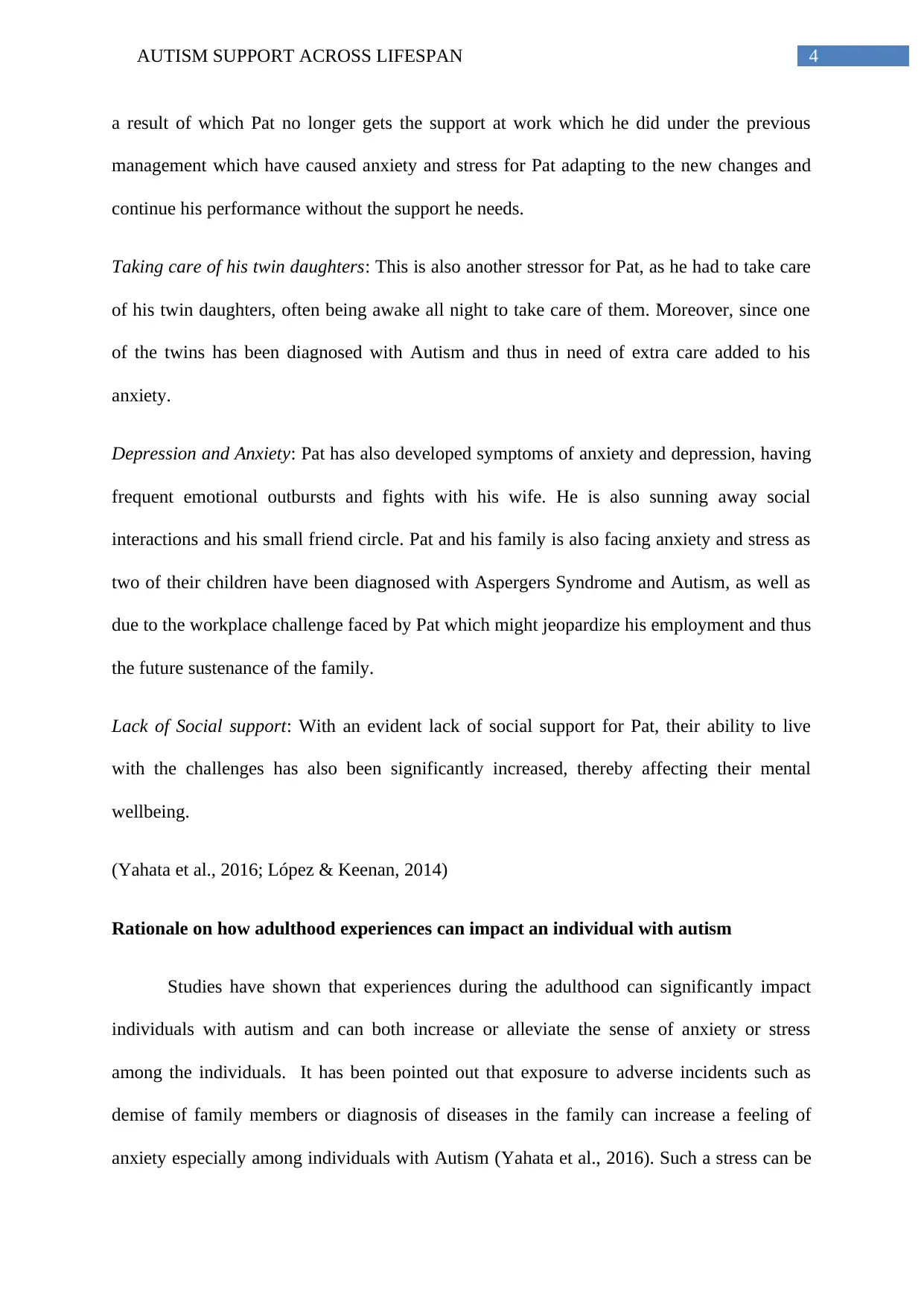
4AUTISM SUPPORT ACROSS LIFESPAN
a result of which Pat no longer gets the support at work which he did under the previous
management which have caused anxiety and stress for Pat adapting to the new changes and
continue his performance without the support he needs.
Taking care of his twin daughters: This is also another stressor for Pat, as he had to take care
of his twin daughters, often being awake all night to take care of them. Moreover, since one
of the twins has been diagnosed with Autism and thus in need of extra care added to his
anxiety.
Depression and Anxiety: Pat has also developed symptoms of anxiety and depression, having
frequent emotional outbursts and fights with his wife. He is also sunning away social
interactions and his small friend circle. Pat and his family is also facing anxiety and stress as
two of their children have been diagnosed with Aspergers Syndrome and Autism, as well as
due to the workplace challenge faced by Pat which might jeopardize his employment and thus
the future sustenance of the family.
Lack of Social support: With an evident lack of social support for Pat, their ability to live
with the challenges has also been significantly increased, thereby affecting their mental
wellbeing.
(Yahata et al., 2016; López & Keenan, 2014)
Rationale on how adulthood experiences can impact an individual with autism
Studies have shown that experiences during the adulthood can significantly impact
individuals with autism and can both increase or alleviate the sense of anxiety or stress
among the individuals. It has been pointed out that exposure to adverse incidents such as
demise of family members or diagnosis of diseases in the family can increase a feeling of
anxiety especially among individuals with Autism (Yahata et al., 2016). Such a stress can be
a result of which Pat no longer gets the support at work which he did under the previous
management which have caused anxiety and stress for Pat adapting to the new changes and
continue his performance without the support he needs.
Taking care of his twin daughters: This is also another stressor for Pat, as he had to take care
of his twin daughters, often being awake all night to take care of them. Moreover, since one
of the twins has been diagnosed with Autism and thus in need of extra care added to his
anxiety.
Depression and Anxiety: Pat has also developed symptoms of anxiety and depression, having
frequent emotional outbursts and fights with his wife. He is also sunning away social
interactions and his small friend circle. Pat and his family is also facing anxiety and stress as
two of their children have been diagnosed with Aspergers Syndrome and Autism, as well as
due to the workplace challenge faced by Pat which might jeopardize his employment and thus
the future sustenance of the family.
Lack of Social support: With an evident lack of social support for Pat, their ability to live
with the challenges has also been significantly increased, thereby affecting their mental
wellbeing.
(Yahata et al., 2016; López & Keenan, 2014)
Rationale on how adulthood experiences can impact an individual with autism
Studies have shown that experiences during the adulthood can significantly impact
individuals with autism and can both increase or alleviate the sense of anxiety or stress
among the individuals. It has been pointed out that exposure to adverse incidents such as
demise of family members or diagnosis of diseases in the family can increase a feeling of
anxiety especially among individuals with Autism (Yahata et al., 2016). Such a stress can be

5AUTISM SUPPORT ACROSS LIFESPAN
further increased with a lack of support for adults with Autism. Since individuals with
Autism can face significant challenges while taking complicated decisions (that requires
analysis and consideration of several variables and factors), they often are highly stressed out
while making important decisions (López & Keenan, 2014). Such stressors can impact both
their physical and mental wellbeing. Stressors can also be caused due to work related and
social factors according to some authors (Ponce et al., 2016; Bejerot et al., 2014). At work,
coping up with the work pressure or changes in the work environment can be a stress of
individuals with Autism. Similarly, stress can also be caused due to workplace bullying and
discrimination that can cause the development of a negative self image and increase the risks
of depressive symptoms among the individuals (Cheak‐Zamora et al., 2015). This can also
inhibit their ability to socialize and engage with communication with others. Social
awkwardness and even social isolation have often been associated with this condition owing
to the inability of Autistic adults being unable to engage with others in discussions which
shows the impact of the social stressors on these individuals (Yahata et al., 2016). Moreover,
the experiences of stress can increase the perceptions of pain and discomfort among
individuals with autism as a result of which various regular conditions such as
gastrointestinal problems can cause immense pain (Burgstahler & Russo-Gleicher, 2015).
Description of changes and challenges throughout generations through an individual
and carer person first lens specific to autism in adulthood
Different changes and challenges are faced by individuals and their care givers in the
context of adulthood autism which has been discussed below:
Dealing with changes- Changes in workplace, social or family environment can be a stress
for individuals with autism as they can find it challenging to cope up with the change.
Individuals with autism often prefer a predictable routine and familiar environment and due
further increased with a lack of support for adults with Autism. Since individuals with
Autism can face significant challenges while taking complicated decisions (that requires
analysis and consideration of several variables and factors), they often are highly stressed out
while making important decisions (López & Keenan, 2014). Such stressors can impact both
their physical and mental wellbeing. Stressors can also be caused due to work related and
social factors according to some authors (Ponce et al., 2016; Bejerot et al., 2014). At work,
coping up with the work pressure or changes in the work environment can be a stress of
individuals with Autism. Similarly, stress can also be caused due to workplace bullying and
discrimination that can cause the development of a negative self image and increase the risks
of depressive symptoms among the individuals (Cheak‐Zamora et al., 2015). This can also
inhibit their ability to socialize and engage with communication with others. Social
awkwardness and even social isolation have often been associated with this condition owing
to the inability of Autistic adults being unable to engage with others in discussions which
shows the impact of the social stressors on these individuals (Yahata et al., 2016). Moreover,
the experiences of stress can increase the perceptions of pain and discomfort among
individuals with autism as a result of which various regular conditions such as
gastrointestinal problems can cause immense pain (Burgstahler & Russo-Gleicher, 2015).
Description of changes and challenges throughout generations through an individual
and carer person first lens specific to autism in adulthood
Different changes and challenges are faced by individuals and their care givers in the
context of adulthood autism which has been discussed below:
Dealing with changes- Changes in workplace, social or family environment can be a stress
for individuals with autism as they can find it challenging to cope up with the change.
Individuals with autism often prefer a predictable routine and familiar environment and due
⊘ This is a preview!⊘
Do you want full access?
Subscribe today to unlock all pages.

Trusted by 1+ million students worldwide

6AUTISM SUPPORT ACROSS LIFESPAN
to the restricted and repetitive interest, high levels of anxiety and different sensory processing
can convert even the smallest change to be highly stressful (Volkmar, 2015).
Anxiety: Severe anxiety problems can be faced by individuals with autism due to their
communication difficulties and a decreased ability to express their feelings which further
makes it difficult to diagnose and treat depression and anxiety among them (Burgstahler &
Russo-Gleicher, 2015).
Planning transitions: Preparing individuals with Autism for regular changes can be a
significant challenge for the caregivers due to an aversion to any change. Helping an
individual with Autism to plan for transitions in care, social life, or work life can help them to
overcome their stress also can be challenging due to their communication problems (Accardo
et al., 2018).
Emotional Instability: One of the biggest challenge while caring for individuals with Autism
is an instability and volatility of emotions that can cause emotional outbursts and panic
attacks which can be debilitating for both the individuals and their families or caregivers.
This can increase the incidence of domestic problems and family conflicts (Volkmar, 2015).
Description of support needs required for the individual and carer using a person first
lens in relation to adulthood
From an understanding of the challenges faced by individuals and their families and
caregivers due to Autism, the following support needs can be identified:
Social Support: This can help individuals with Autism to better take care of their families as
well as help to coordinate care between various care services helping to provide an overall
care for the individuals and their families (Wong et al., 2014).
to the restricted and repetitive interest, high levels of anxiety and different sensory processing
can convert even the smallest change to be highly stressful (Volkmar, 2015).
Anxiety: Severe anxiety problems can be faced by individuals with autism due to their
communication difficulties and a decreased ability to express their feelings which further
makes it difficult to diagnose and treat depression and anxiety among them (Burgstahler &
Russo-Gleicher, 2015).
Planning transitions: Preparing individuals with Autism for regular changes can be a
significant challenge for the caregivers due to an aversion to any change. Helping an
individual with Autism to plan for transitions in care, social life, or work life can help them to
overcome their stress also can be challenging due to their communication problems (Accardo
et al., 2018).
Emotional Instability: One of the biggest challenge while caring for individuals with Autism
is an instability and volatility of emotions that can cause emotional outbursts and panic
attacks which can be debilitating for both the individuals and their families or caregivers.
This can increase the incidence of domestic problems and family conflicts (Volkmar, 2015).
Description of support needs required for the individual and carer using a person first
lens in relation to adulthood
From an understanding of the challenges faced by individuals and their families and
caregivers due to Autism, the following support needs can be identified:
Social Support: This can help individuals with Autism to better take care of their families as
well as help to coordinate care between various care services helping to provide an overall
care for the individuals and their families (Wong et al., 2014).
Paraphrase This Document
Need a fresh take? Get an instant paraphrase of this document with our AI Paraphraser
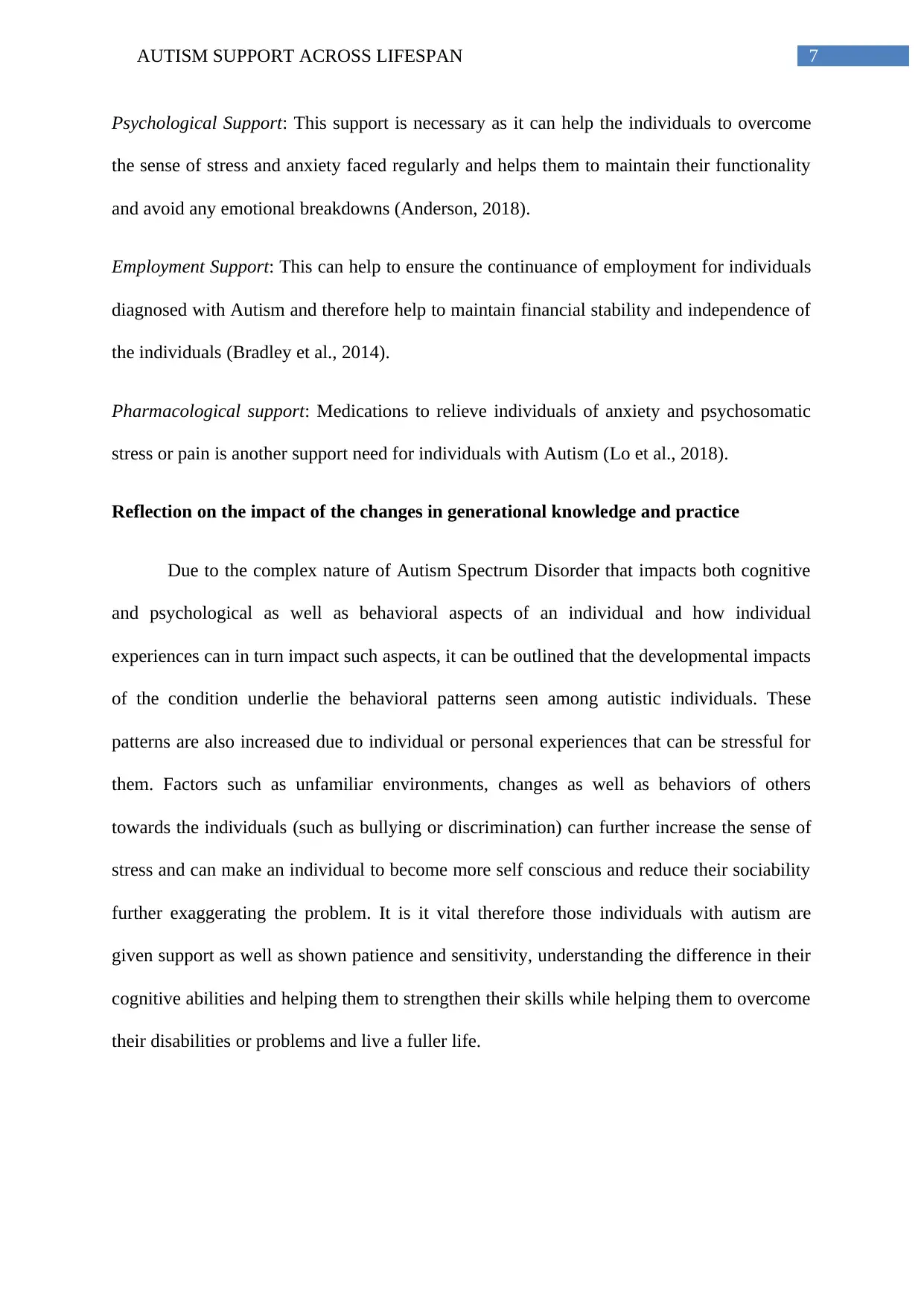
7AUTISM SUPPORT ACROSS LIFESPAN
Psychological Support: This support is necessary as it can help the individuals to overcome
the sense of stress and anxiety faced regularly and helps them to maintain their functionality
and avoid any emotional breakdowns (Anderson, 2018).
Employment Support: This can help to ensure the continuance of employment for individuals
diagnosed with Autism and therefore help to maintain financial stability and independence of
the individuals (Bradley et al., 2014).
Pharmacological support: Medications to relieve individuals of anxiety and psychosomatic
stress or pain is another support need for individuals with Autism (Lo et al., 2018).
Reflection on the impact of the changes in generational knowledge and practice
Due to the complex nature of Autism Spectrum Disorder that impacts both cognitive
and psychological as well as behavioral aspects of an individual and how individual
experiences can in turn impact such aspects, it can be outlined that the developmental impacts
of the condition underlie the behavioral patterns seen among autistic individuals. These
patterns are also increased due to individual or personal experiences that can be stressful for
them. Factors such as unfamiliar environments, changes as well as behaviors of others
towards the individuals (such as bullying or discrimination) can further increase the sense of
stress and can make an individual to become more self conscious and reduce their sociability
further exaggerating the problem. It is it vital therefore those individuals with autism are
given support as well as shown patience and sensitivity, understanding the difference in their
cognitive abilities and helping them to strengthen their skills while helping them to overcome
their disabilities or problems and live a fuller life.
Psychological Support: This support is necessary as it can help the individuals to overcome
the sense of stress and anxiety faced regularly and helps them to maintain their functionality
and avoid any emotional breakdowns (Anderson, 2018).
Employment Support: This can help to ensure the continuance of employment for individuals
diagnosed with Autism and therefore help to maintain financial stability and independence of
the individuals (Bradley et al., 2014).
Pharmacological support: Medications to relieve individuals of anxiety and psychosomatic
stress or pain is another support need for individuals with Autism (Lo et al., 2018).
Reflection on the impact of the changes in generational knowledge and practice
Due to the complex nature of Autism Spectrum Disorder that impacts both cognitive
and psychological as well as behavioral aspects of an individual and how individual
experiences can in turn impact such aspects, it can be outlined that the developmental impacts
of the condition underlie the behavioral patterns seen among autistic individuals. These
patterns are also increased due to individual or personal experiences that can be stressful for
them. Factors such as unfamiliar environments, changes as well as behaviors of others
towards the individuals (such as bullying or discrimination) can further increase the sense of
stress and can make an individual to become more self conscious and reduce their sociability
further exaggerating the problem. It is it vital therefore those individuals with autism are
given support as well as shown patience and sensitivity, understanding the difference in their
cognitive abilities and helping them to strengthen their skills while helping them to overcome
their disabilities or problems and live a fuller life.
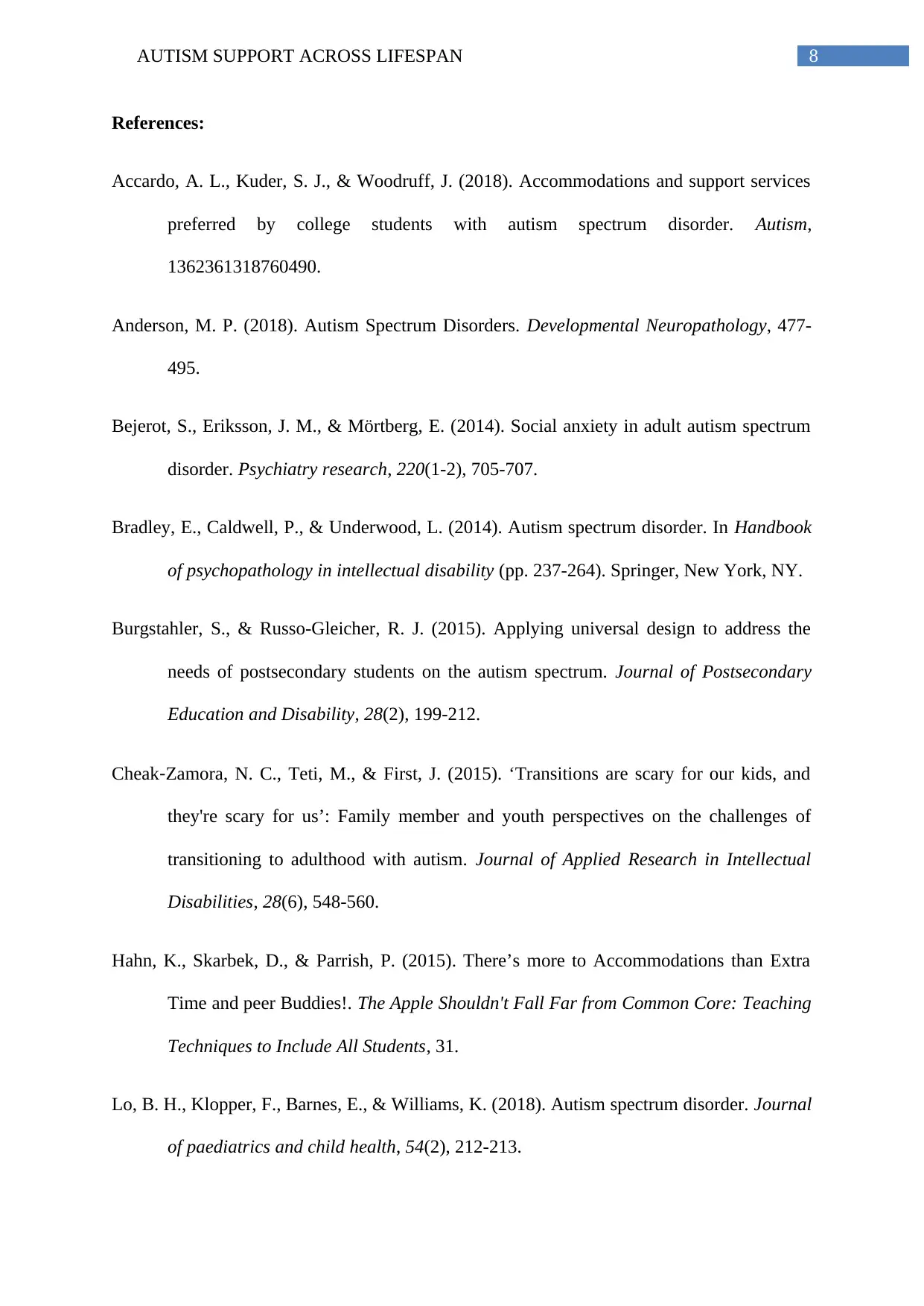
8AUTISM SUPPORT ACROSS LIFESPAN
References:
Accardo, A. L., Kuder, S. J., & Woodruff, J. (2018). Accommodations and support services
preferred by college students with autism spectrum disorder. Autism,
1362361318760490.
Anderson, M. P. (2018). Autism Spectrum Disorders. Developmental Neuropathology, 477-
495.
Bejerot, S., Eriksson, J. M., & Mörtberg, E. (2014). Social anxiety in adult autism spectrum
disorder. Psychiatry research, 220(1-2), 705-707.
Bradley, E., Caldwell, P., & Underwood, L. (2014). Autism spectrum disorder. In Handbook
of psychopathology in intellectual disability (pp. 237-264). Springer, New York, NY.
Burgstahler, S., & Russo-Gleicher, R. J. (2015). Applying universal design to address the
needs of postsecondary students on the autism spectrum. Journal of Postsecondary
Education and Disability, 28(2), 199-212.
Cheak‐Zamora, N. C., Teti, M., & First, J. (2015). ‘Transitions are scary for our kids, and
they're scary for us’: Family member and youth perspectives on the challenges of
transitioning to adulthood with autism. Journal of Applied Research in Intellectual
Disabilities, 28(6), 548-560.
Hahn, K., Skarbek, D., & Parrish, P. (2015). There’s more to Accommodations than Extra
Time and peer Buddies!. The Apple Shouldn't Fall Far from Common Core: Teaching
Techniques to Include All Students, 31.
Lo, B. H., Klopper, F., Barnes, E., & Williams, K. (2018). Autism spectrum disorder. Journal
of paediatrics and child health, 54(2), 212-213.
References:
Accardo, A. L., Kuder, S. J., & Woodruff, J. (2018). Accommodations and support services
preferred by college students with autism spectrum disorder. Autism,
1362361318760490.
Anderson, M. P. (2018). Autism Spectrum Disorders. Developmental Neuropathology, 477-
495.
Bejerot, S., Eriksson, J. M., & Mörtberg, E. (2014). Social anxiety in adult autism spectrum
disorder. Psychiatry research, 220(1-2), 705-707.
Bradley, E., Caldwell, P., & Underwood, L. (2014). Autism spectrum disorder. In Handbook
of psychopathology in intellectual disability (pp. 237-264). Springer, New York, NY.
Burgstahler, S., & Russo-Gleicher, R. J. (2015). Applying universal design to address the
needs of postsecondary students on the autism spectrum. Journal of Postsecondary
Education and Disability, 28(2), 199-212.
Cheak‐Zamora, N. C., Teti, M., & First, J. (2015). ‘Transitions are scary for our kids, and
they're scary for us’: Family member and youth perspectives on the challenges of
transitioning to adulthood with autism. Journal of Applied Research in Intellectual
Disabilities, 28(6), 548-560.
Hahn, K., Skarbek, D., & Parrish, P. (2015). There’s more to Accommodations than Extra
Time and peer Buddies!. The Apple Shouldn't Fall Far from Common Core: Teaching
Techniques to Include All Students, 31.
Lo, B. H., Klopper, F., Barnes, E., & Williams, K. (2018). Autism spectrum disorder. Journal
of paediatrics and child health, 54(2), 212-213.
⊘ This is a preview!⊘
Do you want full access?
Subscribe today to unlock all pages.

Trusted by 1+ million students worldwide

9AUTISM SUPPORT ACROSS LIFESPAN
López, B., & Keenan, L. (2014). Barriers to employment in autism: Future challenges to
implementing the Adult Autism Strategy. Autism Research Network.
Lopez, K., & Gerenser, J. (2017). Autism Spectrum Disorders. In Handbook of Child
Language Disorders (pp. 100-126). Psychology Press.
Ponce, P., Molina, A., & Grammatikou, D. (2016). Design based on fuzzy signal detection
theory for a semi-autonomous assisting robot in children autism therapy. Computers
in Human Behavior, 55, 28-42.
Sanders, S. J., He, X., Willsey, A. J., Ercan-Sencicek, A. G., Samocha, K. E., Cicek, A. E., ...
& Goldberg, A. P. (2015). Insights into autism spectrum disorder genomic
architecture and biology from 71 risk loci. Neuron, 87(6), 1215-1233.
Sarrett, J. C. (2018). Autism and accommodations in higher education: Insights from the
autism community. Journal of autism and developmental disorders, 48(3), 679-693.
Volkmar, F. R. (2015). A Brief History of Autism. In The Molecular Basis of Autism (pp. 3-
14). Springer, New York, NY.
Wong, C., Odom, S. L., Hume, K., Cox, A. W., Fettig, A., Kucharczyk, S., ... & Schultz, T.
R. (2014). Autism Spectrum Disorder. Korean Text of Child Psychiatry. Seoul:
Hakjisa, 149.
Yahata, N., Morimoto, J., Hashimoto, R., Lisi, G., Shibata, K., Kawakubo, Y., ... & Imamizu,
H. (2016). A small number of abnormal brain connections predicts adult autism
spectrum disorder. Nature communications, 7, 11254.
López, B., & Keenan, L. (2014). Barriers to employment in autism: Future challenges to
implementing the Adult Autism Strategy. Autism Research Network.
Lopez, K., & Gerenser, J. (2017). Autism Spectrum Disorders. In Handbook of Child
Language Disorders (pp. 100-126). Psychology Press.
Ponce, P., Molina, A., & Grammatikou, D. (2016). Design based on fuzzy signal detection
theory for a semi-autonomous assisting robot in children autism therapy. Computers
in Human Behavior, 55, 28-42.
Sanders, S. J., He, X., Willsey, A. J., Ercan-Sencicek, A. G., Samocha, K. E., Cicek, A. E., ...
& Goldberg, A. P. (2015). Insights into autism spectrum disorder genomic
architecture and biology from 71 risk loci. Neuron, 87(6), 1215-1233.
Sarrett, J. C. (2018). Autism and accommodations in higher education: Insights from the
autism community. Journal of autism and developmental disorders, 48(3), 679-693.
Volkmar, F. R. (2015). A Brief History of Autism. In The Molecular Basis of Autism (pp. 3-
14). Springer, New York, NY.
Wong, C., Odom, S. L., Hume, K., Cox, A. W., Fettig, A., Kucharczyk, S., ... & Schultz, T.
R. (2014). Autism Spectrum Disorder. Korean Text of Child Psychiatry. Seoul:
Hakjisa, 149.
Yahata, N., Morimoto, J., Hashimoto, R., Lisi, G., Shibata, K., Kawakubo, Y., ... & Imamizu,
H. (2016). A small number of abnormal brain connections predicts adult autism
spectrum disorder. Nature communications, 7, 11254.
1 out of 10
Your All-in-One AI-Powered Toolkit for Academic Success.
+13062052269
info@desklib.com
Available 24*7 on WhatsApp / Email
![[object Object]](/_next/static/media/star-bottom.7253800d.svg)
Unlock your academic potential
Copyright © 2020–2025 A2Z Services. All Rights Reserved. Developed and managed by ZUCOL.

